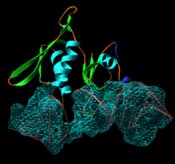

 t the forefront of biomedical research, medical scientists use particle accelerators to explore the structure of biological molecules. They use the energy that charged particles emit when accelerated to nearly the speed of light to create one of the brightest lights on earth, 30 times more powerful than the sun and focused on a pinpoint.
t the forefront of biomedical research, medical scientists use particle accelerators to explore the structure of biological molecules. They use the energy that charged particles emit when accelerated to nearly the speed of light to create one of the brightest lights on earth, 30 times more powerful than the sun and focused on a pinpoint.
Deciphering the structure of proteins is key to understanding biological processes and healing disease. To determine a protein's structure, researchers direct the beam from an accelerator called a synchrotron through a protein crystal. The crystal scatters the beam onto a detector. From the pattern of scattering, computers calculate the position of every atom in the protein molecule and create
a 3-D image of the molecule.
 Physicists originally built synchrotron accelerators to explore the fundamental nature of matter. At first, they looked on synchrotron radiation as a troublesome problem that sapped electrons� acceleration energy. However, they soon saw the potential to use this "nuisance" energy to create ultrapowerful beams to study biological molecules and other materials. Physicists originally built synchrotron accelerators to explore the fundamental nature of matter. At first, they looked on synchrotron radiation as a troublesome problem that sapped electrons� acceleration energy. However, they soon saw the potential to use this "nuisance" energy to create ultrapowerful beams to study biological molecules and other materials.
Now, researchers at synchrotron light sources use dedicated particle accelerators to explore the molecules of life with matchless power and precision. Future accelerators will create still higher-energy beams for both particle physics and biomedicine.
|